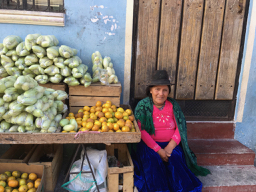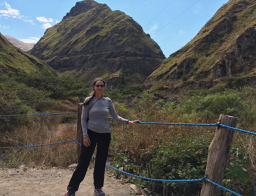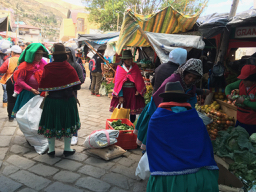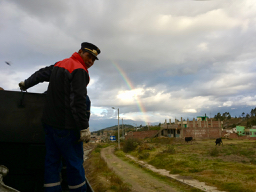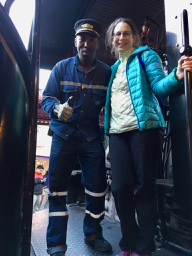Our train is passing through a landscape of primeval heavy woods, fed by the waterfalls and constant dripping moisture from the forest canopy absorbing the water coming from the Pacific ocean. I thought we would face heavy fog all day, as we experienced this morning when we left Bucay, but suddenly the sun is shining above us and I almost expect to see rainbows slicing across the hills and river fed valleys, like a Turner painting. Red leaves and green leaved trees reach thirstily upward on the hillsides and blossoms of white and pink and purple are scattered on shrubs as the train slowly moves steadily uphill. We pass small homes and not many people. At each road crossing, red vested security guards on motorcycles stand sentry over the local people who happily wave at us passing by.
We stop in the town of Huigra, a short main street with the track tracks down the middle, set between two hills in a beautiful valley — said to have spring weather all year —- where there are few shops and one 3-story building. The Lady of Guadaloupe stands on the high hillside in her shrine guarding the inhabitants and life here has changed little over time. This area has been for centuries a stop for tropical produce and products from the coast going inland and from the Andes toward the seaside towns. The train route has solidified this specific spot as a central meeting place where once people and mules passed over on their hillside caravans, an altitude halfway between the high mountains and the lowlands.
As our engine, now diesel, chugs uphill, the landscape has changed from tropical lush forest to more arid flora, brown now the dominating color. The altitude limits life here. We stop at the base of the famous “Nariz del Diablo”, “Devil’s Nose”, a sharp round hill around which the train must traverse back and forth to reach another level of height and move on.
To do this, there are several switch backs at which the train must stop, back up on an adjacent rail, and then move forward again. The hill drops off sharply below us as we view the landscape, brown on one side and with touch of green on the hillsides once around the bend.
In Alausi, with a main street of multi-colored houses, we descend for a stretch and there is a Sunday Market, filled with fresh fruits, vegetables and meats, looking much fresher than I have seen in other countries, perhaps the high altitude keeps down the flies and other pests. This town is filled with women in traditional dress, below-the knee bright red or blue or green skirts with extensive embroidery at the bottom, with a bright contrasting shawl thrown over one shoulder, and a felt bowler hat, often decorated with a ribbon or feather. I thought this might be because it is Sunday but asked the train guide who said this is their everyday clothes as well. One very old couple was almost completely bent over, undoubtedly from a lifetime of carrying heavy loads up steep inclines and given the general shortness of the people here, this couple probably was no more than 4 feet tall. Our guide related to us that just as plants grow shorter in higher altitudes to preserve moisture and air better, so are the Ecuadorian indigenous Andes groups in general very short. The harshness of the climate is reflected in their faces, brown from the sun and serious.
The camera crew at work.
Colta is a stop for an experience with the local Puruha population, who are both agricultural and herders, with llamas and alpacas for both fur/hair and meat. We are at a fairly high elevation now and our short walk up a hill leaves some people a little short of breath. The English speaking group (7 of us) walks along a dirt path to a field and is shown by a local women, through our translator, the many grains that grow easily here — quinoa, oats, barley, and the lupin bean, a white bean I have not seen at home. Large agave plants are used for plot borders as well as being used as a fiber, as a sewing needle, as a soap, and as we know as a sweetener. As our guide pointed out, people do not go hungry here. Below is our English-speaking group with a snow-capped volcano in the background
Food continues to be a star on this trip: a morning snack and lunch on board with Kim and Kathleen from Australia.
We pick up the Black Monster, the last steam train to come off the production belt of the Baldwin foundry in Pennsylvania in the 1950’s, and head off toward Riobamba, our stop for the night. The observation car is now right behind the engine and I spend the entire trip with a cold wind blowing with the black smoke sweeping over me and two fire men working the engine in front of me and the loud steam whistle periodically blowing and the even louder clacking of the wheels on the rails — it is fabulous.
On our way to Riobamba, traveling through a valley, a mist begins and a rainbow does indeed streak across the sky, and above the town the glowing volcano emerges.
Once in Riobamba, our final stop for the day, I have a chance to look closeup at the steam engine and am allowed into the Engineer’s cabin, the suitable completion to this part of the journey.
Riobamba is at an elevation of 9000 feet. A luxurious hacienda stay awaits us, dinner, and another early rise.
.



